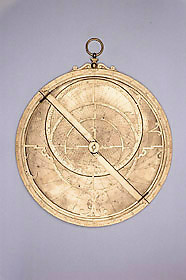
 |
| Catalogue |
 |
 Astrolabe The inside of the mater is engraved with a latitude plate for 'G.43 M.40' appropriate to Florence. There are azimuths for every 5 degrees, numbered by 10, and almucantars for every 2 degrees, numbered by 6, meridian line, east-west line, tropics, equator, and crepuscular line. There are lines for equal hours below the horizon, numbered 1 to 12 by 1, and lines dividing the houses of heaven with Roman numerals I to XII by 1. Engraved coat of arms and '?F? EGNATIVS DANTES?'. Rete for 31 named stars, with bands for the tropics and equator as well as the ecliptic. The meridian band is counterchanged 6 times, the east-west band 8 times and broken twice. The ecliptic band is pierces twice for star positions. It has the names and symbols of the signs, each with a 30-degree scale, divided to 10, subdivided to 5 and to 1, numbered by 10. The equatorial band has an incomplete degree scale from the vernal equinox 0 to 360, divided to 10, subdivided to 5, numbered by 10. The back has an outer degree scale 0 at the throne to 90 to 0 to 90 to 0. Rojas universal projection with right ascension arcs marked with hours 1 to 12, 'HORE ANTE MERIDIAM', above the Tropic of Cancer and 12 to 1, 'HORE POST MERIDIEM', beneath the Tropic of Capricorn. Between the tropics are lines of declination for every 5 degrees of the zodiac, with symbols for the signs. Whole hour lines and the beginning of each sign are marked by added dots. A number of named stars are marked on the projection. A diametric line is drawn for the ecliptic. A pair of rules, are provided for the universal projection: a diametric rule with a linear scale for degrees, 0 at the centre and returning to the centre at 180 and 360, divided to 10, subdivided to 5 and to 1, numbered by 10, and a half-diameter with a sliding joint in the shape of a grotesque head, with a scale 0 to 90 to 0 in either edge, divided to 10, subdivided to 5 and to 1, numbered by 10. Decorated alidade with pin and slit sights. Pin attached to the diametric rule and wedge. See R. T. Gunther, The Astrolabes of the World (2 vols, Oxford, 1932), vol. 2, pp. 332-3 and G. L'E. Turner, "The Florentine Workshop of Giovan Battista Giusti, 1556-c.1575", Nuncius, 10 (1995), pp. 131-72. Jim Bennett |



